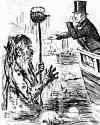
On 7 Jul 1855, a letter from Michael Faraday was published in The Times newspaper, London. He decried the deplorable polluted state of the River Thames. Its stench was truly horrendous in Victorian times.
On a boat trip, Faraday wrote, he had observed: “The whole of the river was an opaque pale brown fluid. In order to test the degree of opacity, I … dropped [pieces of card] into the water at every pier the boat came to; before they had sunk an inch below the surface they were indistinguishable, though the sun shone brightly at the time.” His words, he said, were no exaggeration, they were “the simple truth.” He asserted, “If there be sufficient authority to remove a putrescent pond from the neighbourhood of a few simple dwellings, surely the river which flows for so many miles through London ought not to be allowed to become a fermenting sewer.”
You can read Faraday’s Letter to The Times in full, together with a cartoon from the satirical Punch magazine that followed later in the month, showing “Faraday giving his card to Father Thames.”

On 7 Jul 1996, Ian Wilmut was born, who in 1996 supervised the team of scientists that produced Dolly, a cloned sheep, at the Roslin Institute, Edinburgh, Scotland. It was a pivotal moment in history, when Dolly became the first mammal cloned from a cell from an adult. It was a breakthrough that revolutionized three technologies—genetic engineering, genomics, and cloning by nuclear transfer from adult cells.
Today's book pick is: The Second Creation: Dolly and the Age of Biological Control, by Ian Wilmut, Keith Campbell, Colin Tudge. Written by the noted science author Colin Tudge, the book is based on interviews with Ian Wilmut and Keith Campbell, the scientists who cloned Dolly the sheep. They reveal their contribution to genetic engineering and cloning, and the control that science has over the process of life. The book’s aim is to explain the story of how and why they came to cloning sheep and the implications for the future, from curing diseases to human cloning.
It is available from Amazon, typically about Used from $6.52. (As of earlier time of writing - subject to change.)
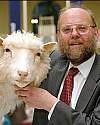 | I see nothing wrong ethically with the idea of correcting single gene defects [through genetic engineering]. But I am concerned about any other kind of intervention, for anything else would be an experiment, [which would] impose our will on future generations [and take unreasonable chances] with their welfare ... [Thus] such intervention is beyond the scope of consideration. |
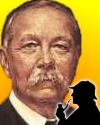 | Detection is, or ought to be, an exact science, and should be treated in the same cold unemotional manner. You have attempted to tinge it with romanticism, which produces the same effect as if you worked a love-story into the fifth proposition of Euclid. |
 | The late James McNeil Whistler had a French poodle of which he was extravagantly fond. This poodle was seized with an affection of the throat, and Whistler had the audacity to send for the great throat specialist, Mackenzie. Sir Morell, when he saw that he had been called to treat a dog, didn't like it much, it was plain. But he said nothing. He prescribed, pocketed a big fee, and drove away. The next day he sent posthaste for Whistler. And Whistler, thinking he was summoned on some matter connected with his beloved dog, dropped his work and rushed like the wind to Mackenzie's. On his arrival Sir Morell said, gravely: “How do you do, Mr. Whistler? I wanted to see you about having my front door painted.” |
| Before you look at today's web page, see if you can answer some of these questions about the events that happened on this day. Some of the names are very familiar. Others will likely stump you. Tickle your curiosity with these questions, then check your answers on today's web page. | |
| Births | |
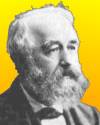 | Rudolf Wolf, born 7 Jul 1816, was a Swiss astronomer and astronomical historian. Wolf’s main contribution was a discovery concerning sunspots activity over time. He was the co-discoverer of their connection with geomagnetic activity on Earth. What did he discover about sunspots? |
| | Joseph Marie Jacquard, born 7 Jul 1752, was a French silk weaver and inventor of a power loom for brocaded fabric. His loom would mechanically produce any pattern. What method did he devise to control the loom, and how did it develop into an application in computers? |
| Deaths | |
 | Arthur Conan Doyle (1859-1930) wrote many books whose main character, Sherlock Holmes, emulates the scientist, diligently searching through data to make sense of it. “It is a capital mistake to theorize before one has data. Insensibly one begins to twist facts to suit theories, instead of theories to suit facts." Although he edited a student newspaper, and a journalist uncle encouraged him to write, it was not the career for which he studied at university. When unable to establish himself in that profession, he turned more successfully to full-time writing. For what profession did Doyle study? |
| Events | |
 | On 7 Jul 1936, several U.S. patents were issued to its inventor, Henry F. Phillips for a fastener and fastening system. What was the fastener, and which industry adopted it? |
 | On 7 Jul 1668, Isaac Newton received something for his work over the previous few years. What did he receive? |
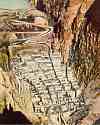 | On 7 Jul 1930, construction began on the site infrastructure for construction of the Boulder Dam (later renamed as Hoover Dam). It had taken decades of political wrangling, but construction was finished in five years, and it was dedicated on 30 Sep 1935. The gravity-arch dam impounds a lake, the largest reservoir in the U.S., that provides electricity, municipal water, flood control and irrigation. On which river, and between which states was the dam built? What is the name of the lake formed by the dam? |
Fast answers for the previous newsletter for July 6: American Ornithology (birds) • French • PET (polyethylene terephthalate) • Georg Ohm • rabies • the decade including the year 1905 • the decade including the year 1952.
 If you enjoy this newsletter, the website, or wish to offer encouragement or ideas, please send feedback by using your mail reader Reply button.
If you enjoy this newsletter, the website, or wish to offer encouragement or ideas, please send feedback by using your mail reader Reply button. Your click on a Facebook, StumbleUpon, or other social button on the site webpages is also a welcome sign of appreciation. Thank you for using them.
© This newsletter is copyright 2020 by todayinsci.com. Please respect the Webmaster's wishes and do not put copies online of the Newsletter — or any Today in Science History webpage. (If you already have done so, please remove them. Thank you.) Offline use in education is encouraged such as a printout on a bulletin board, or projected for classroom viewing. Online, descriptive links to our pages are welcomed, as these will provide a reader with the most recent revisions, additions and/or corrections of a webpage. For any other copyright questions, please contact the Webmaster by using your mail reader Reply button.
--
If you do not want to receive any more newsletters, Unsubscribe
To update your preferences and to unsubscribe visit this link
Executive Real Estate Business Class
-
"It was like a man with wings. It wasn't like anything you'd see on TV or in a monster movie." ...
About the publisher
Search This Blog
Blog Archive
-
▼
2021
(585)
-
▼
July
(50)
- Newsletter for Saturday 31 July.
- Newsletter for Friday 30 July.
- Power off and play this summer!
- Newsletter for Thursday 29 July.
- Newsletter for Wednesday 28 July.
- Newsletter for Tuesday 27 July.
- Newsletter for Monday 26 July.
- Newsletter for Sunday 25 July.
- Newsletter for Saturday 24 July.
- Newsletter for Friday 23 July.
- Newsletter for Thursday 22 July.
- Newsletter for Wednesday 21 July.
- Newsletter for Tuesday 20 July.
- Newsletter for Monday 19 July.
- The Machines That Built America Premieres Tonight
- Newsletter for Sunday 18 July.
- Newsletter for Saturday 17 July.
- Newsletter for Friday 16 July.
- Newsletter for Thursday 15 July.
- Newsletter for Wednesday 14 July.
- Newsletter for Tuesday 13 July.
- On This Day for July 12 - Geraldine Ferraro design...
- Newsletter for Monday 12 July.
- Inventing ‘The Machines That Built America’
- On This Day for July 11 - Duel between Aaron Burr ...
- Newsletter for Sunday 11 July.
- On This Day for July 10 - Telstar 1 launched, John...
- Newsletter for Saturday 10 July.
- On This Day for July 9 - Catherine the Great assum...
- Newsletter for Friday 9 July.
- New Season! Hope, Through History Podcast
- On This Day for July 8 - Vasco da Gama's first voy...
- Newsletter for Thursday 8 July.
- Ending soon: savings that pop! 🎆
- On This Day for July 7 - Hawaiian Islands annexed ...
- Newsletter for Wednesday 7 July.
- On This Day for July 6 - Anne Frank forced into hi...
- Newsletter for Tuesday 6 July.
- On This Day for July 5 - Israel's Law of Return pa...
- Newsletter for Monday 5 July.
- On This Day for July 4 - Declaration of Independen...
- Newsletter for Sunday 4 July.
- July 4th Sale at the HISTORY Store!
- On This Day for July 3 - Battle of Gettysburg ende...
- Newsletter for Saturday 3 July.
- On This Day for July 2 - Civil Rights Act signed, ...
- Newsletter for Friday 2 July.
- July 4th savings that pop!
- On This Day for July 1 - Dominion of Canada establ...
- Newsletter for Thursday 1 July.
-
▼
July
(50)
-
Blogroll
-
About
HistoryFact










0 comments:
Post a Comment